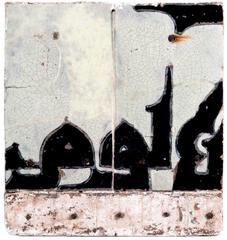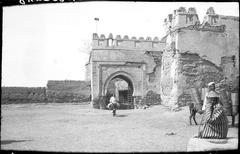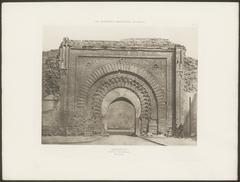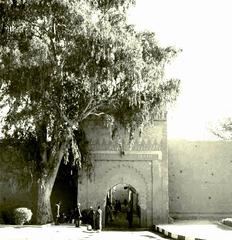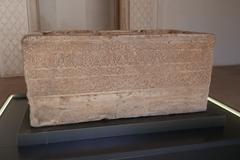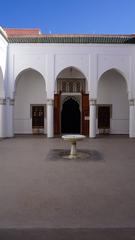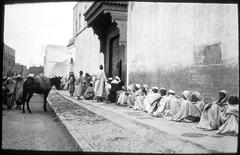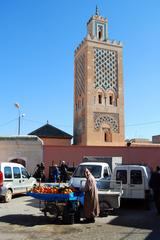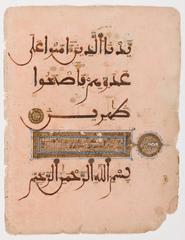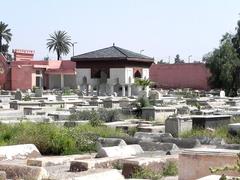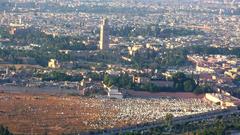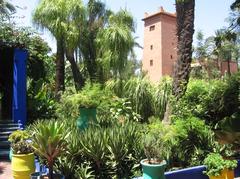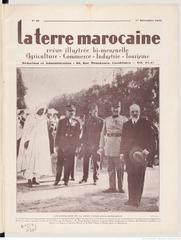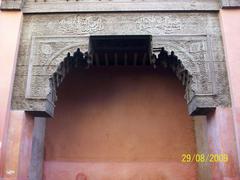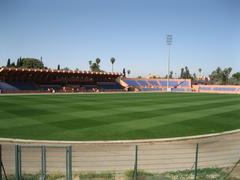Slat Al Azama Synagogue Visiting Hours, Tickets, and Historical Significance in Marrakesh, Morocco
Date: 14/06/2025
Introduction
Nestled within the historic Mellah quarter of Marrakesh, the Slat Al Azama Synagogue stands as a living testament to the enduring legacy of Morocco’s Jewish community. Founded by Sephardic Jews expelled from Spain in 1492, this landmark encapsulates centuries of religious, architectural, and social history. It is both a spiritual sanctuary and a center of education, reflecting the vibrant coexistence and cultural synthesis unique to Moroccan Jewish heritage. Today, it remains one of Marrakesh’s most iconic Jewish sites, welcoming visitors to its serene prayer hall, museum, and courtyard, and offering a window into Morocco’s pluralistic past and present (Morocco Travel Blog; Private Tours Marrakech; Wanderlog).
This comprehensive guide provides essential information on visiting hours, ticketing, accessibility, guided tours, nearby attractions, and the synagogue’s historical and architectural significance. Whether you are a history enthusiast, traveler, or local, this resource will enrich your experience and ensure a respectful, informed visit.
Table of Contents
- Introduction
- Historical Background and Foundation
- Architectural Features and Evolution
- Role in the Jewish Community
- Preservation and Modern Restoration
- Visitor Information: Hours, Tickets, and Tips
- Slat Al Azama in Moroccan Jewish Context
- Nearby Attractions and Travel Advice
- Frequently Asked Questions (FAQ)
- Conclusion
- References
Historical Background and Foundation
Slat Al Azama, also known as Lazama Synagogue, was established in the Mellah, Marrakesh’s Jewish quarter, by Sephardic Jews fleeing the Alhambra Decree of 1492 (Kiddle). Though tradition attributes its foundation to that year, the Mellah itself was formally established in 1557 under the Saadian dynasty, complicating precise dating. The creation of the Mellah marked a turning point in Moroccan Jewish history, as Sultan Moulay Abdallah offered protection and relative autonomy to the Jewish community, who built the synagogue as a central hub for worship, learning, and communal life (Morocco Travel Blog).
Architectural Features and Evolution
Exterior and Courtyard
The synagogue is integrated within a traditional residential building, typical of Moroccan urban design. A discreet street entrance leads into a beautifully tiled courtyard, the heart of both spiritual and communal activities. The blue-and-white zellij tilework, central fountain, and lush potted plants create an atmosphere of tranquility and purity, echoing both Moroccan and Jewish aesthetics.
Interior and Sanctuary
The main prayer hall is rectangular, with rows of wooden benches facing an ornate Torah ark on the eastern wall. The interior displays intricate carved wood, colorful Moroccan carpets, and whitewashed walls. The women’s gallery (ezrat nashim), added after the 1950s, is a unique architectural feature in Moroccan synagogues—traditionally, women would have remained in a separate area, not in a gallery overlooking the sanctuary.
Liturgical and Artistic Details
The wooden bimah, where Torah readings take place, stands at the center. The Torah ark, now made of marble, and the burgundy curtain adorned with Hebrew script, reflect Sephardic tradition. Chandeliers and natural light create a contemplative atmosphere, while the use of local stone, brick, and lime plaster ensures the building endures Marrakesh’s climate.
Restoration
The synagogue has undergone several restorations, most recently in the early 2000s and following the 2023 earthquake, to preserve its historical integrity and adapt to visitor needs. Restoration efforts have focused on structure, decorative elements, and the addition of a small museum displaying artifacts and archival photographs (Morocco Travel Blog).
Role in the Jewish Community
Slat Al Azama served as the first synagogue for the Megorashim (Spanish Jewish exiles) in Marrakesh, anchoring their spiritual and communal life. It was a venue for daily prayer, festivals, and communal decision-making. The synagogue’s historical proximity to the Miara Jewish Cemetery, where many rabbis and leaders are buried, further underscores its significance (Morocco Travel Blog). Notable figures such as Rabbi Avraham Kurkus, Rabbi Avraham Pinto, and Rabbi Shlomo Amar have been associated with its legacy.
Preservation and Modern Restoration
With the Jewish population of Marrakesh now numbering only a few families, the synagogue remains active, holding services several evenings each week and on Shabbat. Restoration initiatives have included structural repairs, preservation of decorative arts, and the creation of a museum space. These efforts, supported by both local and international organizations, ensure that Slat Al Azama continues to serve as a beacon of cultural memory and interfaith dialogue (Private Tours Marrakech; Friendly Morocco).
Visitor Information: Hours, Tickets, and Tips
- Visiting Hours: The synagogue is generally open daily from 9:00 AM to 5:00 PM. Hours may vary during Jewish holidays or for Shabbat (Friday evening to Saturday evening), when access is limited to worshippers. Always check ahead for up-to-date schedules (Atlas Obscura; Wanderlog).
- Admission: An entrance fee of 10–20 MAD (about $1–$2 USD) helps support preservation. Guided tours may incur additional costs.
- Guided Tours: Available in multiple languages; booking ahead is recommended for deeper historical insight.
- Accessibility: While the main entrance and courtyard are accessible, upper galleries and some areas may require stairs. The historic architecture limits full accessibility.
- Etiquette: Dress modestly (shoulders and knees covered), maintain silence or low voices, and be respectful during services. Photography is generally permitted, but flash and photographing worshippers or certain artifacts may be restricted—ask for permission.
- Location: Located in the Mellah (Derb Saka, Hay Essalam, Marrakesh), within walking distance of the Bahia Palace, Jemaa el-Fnaa, and the Miara Jewish Cemetery (Wanderlog).
- Nearby Amenities: Cafés, restaurants, and shops are nearby; bring cash for entrance fees and purchases.
- Travel Tips: Visit early to avoid crowds and midday heat, especially in spring and autumn. Comfortable walking shoes are recommended for navigating the Medina’s narrow streets.
Slat Al Azama in Moroccan Jewish Context
The synagogue is emblematic of the broader history of Morocco’s Jews, who have lived in the region for over two millennia. The arrival of the Megorashim forged a new chapter, blending Spanish and local traditions. Despite the dramatic decline in Morocco’s Jewish population since the mid-20th century, Slat Al Azama remains a site of pilgrimage, memory, and ongoing religious life. It also stands as a symbol of Morocco’s longstanding values of coexistence and religious tolerance (Friendly Morocco).
Nearby Attractions and Travel Advice
- Miara Jewish Cemetery: A short walk from the synagogue, featuring distinctive white tombs and centuries of history.
- Bahia Palace: An architectural masterpiece of Moroccan design, located nearby.
- Jemaa el-Fnaa: Marrakesh’s famous central square, offering a vibrant atmosphere, local cuisine, and shopping.
- Medina Markets: Explore traditional souks for handicrafts, spices, and textiles.
Combining a visit to the synagogue with these sites offers a comprehensive view of Marrakesh’s multicultural heritage.
Frequently Asked Questions (FAQ)
Q: What are the visiting hours for Slat Al Azama Synagogue?
A: Generally open from 9:00 AM to 5:00 PM daily, but hours may vary during Jewish holidays and Shabbat.
Q: Is there an entrance fee?
A: Yes, a modest fee of 10–20 MAD supports site preservation.
Q: Can I take photographs inside?
A: Photography is permitted in most areas, but ask permission, especially if worshippers are present.
Q: Are guided tours available?
A: Yes, in multiple languages. Booking in advance is recommended.
Q: Is the synagogue accessible for those with disabilities?
A: Main areas are accessible, but some parts (like the women’s gallery) require stairs.
Q: What else can I visit nearby?
A: The Miara Jewish Cemetery, Bahia Palace, Jemaa el-Fnaa, and Medina markets are all within walking distance.
Conclusion
The Slat Al Azama Synagogue remains a captivating symbol of Marrakesh’s Jewish heritage and Morocco’s enduring commitment to cultural diversity. From its roots in the Sephardic diaspora to its continued function as a place of worship and education, it invites visitors to engage with centuries of resilience, adaptation, and coexistence. Thoughtful preservation ensures that future generations will continue to appreciate this architectural and spiritual treasure. For an enriched visit and to stay updated on travel tips and cultural events, consider downloading the Audiala app and exploring further resources on Marrakesh’s historic landmarks.
References
- Slat Al Azama Synagogue in Marrakesh: Visiting Hours, Tickets & Historical Guide, 2020, Morocco Travel Blog (Morocco Travel Blog)
- Visiting Slat Al Azama Synagogue in Marrakesh: Hours, Tickets, and Historical Insights, 2024, Private Tours Marrakech (Private Tours Marrakech)
- Slat Al Azama Synagogue in Marrakesh: Visiting Hours, Tickets & Historical Significance, 2023, Friendly Morocco (Friendly Morocco)
- Slat Al Azama Synagogue Visiting Hours, Tickets & Guide to Marrakesh’s Historic Jewish Site, 2023, Wanderlog (Wanderlog)
- Slat Al Azama Synagogue, Marrakesh: A Historic Jewish Landmark, 2022, Morocco World News (Morocco World News)
- Slat Al Azama Synagogue, 2024, Atlas Obscura (Atlas Obscura)
- A Guide to Marrakesh’s Jewish Quarter, Culture Trip (Culture Trip)
- Slat Al Azama Synagogue, Lonely Planet (Lonely Planet)
- Morocco International Travel Information, U.S. Department of State (U.S. Department of State)
- Slat al-Azama Synagogue, Kiddle (Kiddle)
